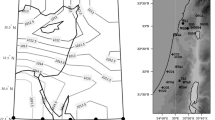Abstract
A cyclone genesis parameter, termed the genesis potential parameter (GPP), for the Indian Sea is proposed. The parameter is defined as the product of four variables, namely vorticity at 850 hPa, middle tropospheric relative humidity, middle tropospheric instability, and the inverse of vertical wind shear. The variables are calculated using the National Centers for Environmental Prediction (NCEP), USA, reanalysis data, averaged within a circle of 2.5° radius around the centre of cyclonic system. The parameter is tested with a sample dataset of 35 nondeveloping and developing low-pressure systems that formed over the Indian Sea during the period 1995–2005. The result shows that there is a distinction between GPP values for nondeveloping and developing systems in more than 85% cases. The composite GPP value is found to be around three to five times greater for developing systems than for nondeveloping systems. The analysis of the parameter at early development stage of a cyclonic storm appears to provide a useful predictive signal for intensification of the system.








Similar content being viewed by others
References
Camargo SJ, Emanuel KA, Sobel AH (2007) Use of a Genesis Potential Index to diagnose ENSO effects on tropical cyclone genesis. J Clim 20:4819–4834. doi:10.1175/JCLI4282.1
DeMaria M, Knaff JA, Bernadette HC (2001) A tropical cyclone genesis parameter for the tropical Atlantic. Weather Forecast 16:219–233. doi:10.1175/1520-0434(2001)016<0219:ATCGPF>2.0.CO;2
Dvorak VF (1975) Tropical cyclone intensity analysis and forecasting from satellite imagery. Mon Weather Rev 103:420–430. doi:10.1175/1520-0493(1975)103<0420:TCIAAF>2.0.CO;2
Elsberry RL, Jeffries R (1996) Vertical wind shear influences on tropical cyclone formation and intensification during TCM-92 and TCM-93. Mon Weather Rev 124:1374–1387. doi:10.1175/1520-0493(1996)124<1374:VWSIOT>2.0.CO;2
Franklin JL, Lord SJ, Feuer SE, Marks FD (1993) The kinematic structure of Hurricane Gloria (1985) determined from nested analysis of dropsonde and Doppler radar data. Mon Weather Rev 121:2433–2451. doi:10.1175/1520-0493(1993)121<2433:TKSOHG>2.0.CO;2
George JJ (1960) Weather forecasting For aeronautics. Academic Press, USA, p 673
Gray WM (1968) Global view of the origin of tropical disturbances and storms. Mon Weather Rev 96:669–700. doi:10.1175/1520-0493(1968)096<0669:GVOTOO>2.0.CO;2
Gray WM (1975) Tropical cyclone genesis. Dept. of Atmos. Sc., Paper No. 232, Colorado State University, Port Collins Co., USA, p 121
Gray WM (1978) Hurricane and their formation structure and likely role in the tropical circulation. Prepared for the RMS/AMS conference on met. over the tropical oceans, London, August 21–25 1978 and RMS conference volume
Kalsi SR, Srivastava KB (2006) Characteristic features of Orissa super cyclone of 29th October, 1999 as observed through CDR Paradip. Mausam (New Delhi) 57:21–30
Kotal SD, Roy Bhowmik SK, Kundu PK, Das AK (2008) A Statistical Cyclone Intensity Prediction (SCIP) Model for Bay of Bengal. J Earth Syst Sci 117:157–168. doi:10.1007/s12040-008-0006-1
Mandal GS, Rao AVRK, Gupta SC (1981) Characteristics of an Arabian Sea cyclone. Mausam (New Delhi) 32:139–144
McBride JL (1981) Observational analysis of tropical cyclone formation. Part III: budget analysis. J Atmos Sci 38:1152–1166. doi:10.1175/1520-0469(1981)038<1152:OAOTCF>2.0.CO;2
McBride JL, Zehr RM (1981) Observational analysis of tropical cyclone formation. Part II: comparison of non-developing versus developing systems. J Atmos Sci 38:1132–1151. doi:10.1175/1520-0469(1981)038<1132:OAOTCF>2.0.CO;2
Palmen EN (1948) On the formation and structure of the tropical hurricane. Geophysica 3:26–38
Roy Bhowmik SK (2003) An evaluation of cyclone genesis parameter over the Bay of Bengal using model analysis. Mausam (New Delhi) 54:351–358
Roy Bhowmik SK, Kotal SD, Kalsi SR (2007) An empirical model for predicting intensity of tropical cyclone over the Bay of Bengal. Nat Hazards 41:447–455. doi:10.1007/s11069-006-9053-6
Royer J-F, Chauvin F, Timbal B, Araspin P, Grimal D (1998) A GCM study of the impact of greenhouse gas increase on the frequency of occurrence of tropical cyclone. Clim Change 38:307–343. doi:10.1023/A:1005386312622
Zehr RM (1992) Tropical cyclogenesis in the western north Pacific. NOAA Tech. Rep. NESDIS 61, 181pp
Zeng Z, Wang Y, Wu CC (2007) Environmental dynamical control of tropical cyclone intensity—an observational study. Mon Weather Rev 135:38–59. doi:10.1175/MWR3278.1
Acknowledgements
The authors are grateful to the Director General of Meteorology, India Meteorological Department, New Delhi for providing all the facilities to carry out this research work. The authors acknowledge the use of NCEP data in this research work and are grateful to the anonymous reviewers for their valuable comments to improve the quality of the paper.
Author information
Authors and Affiliations
Corresponding author
Rights and permissions
About this article
Cite this article
Kotal, S.D., Kundu, P.K. & Roy Bhowmik, S.K. Analysis of cyclogenesis parameter for developing and nondeveloping low-pressure systems over the Indian Sea. Nat Hazards 50, 389–402 (2009). https://doi.org/10.1007/s11069-009-9348-5
Received:
Accepted:
Published:
Issue Date:
DOI: https://doi.org/10.1007/s11069-009-9348-5



